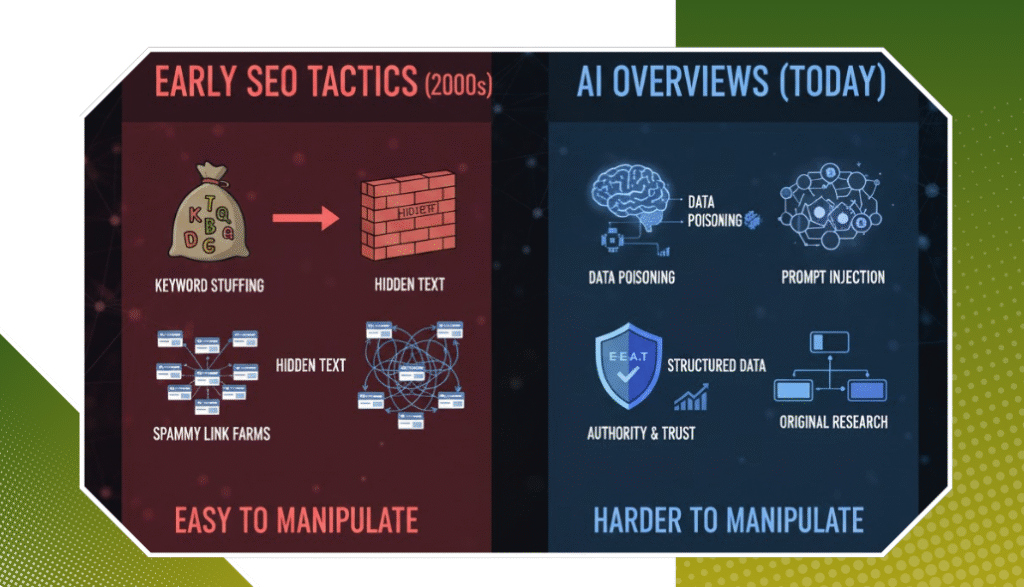While this innovation enhances user experience by offering quick, consolidated answers, it also disrupts traditional SEO strategies that once relied heavily on organic clicks. In this blog, we’ll explore how Google AI Overview is reshaping the SEO landscape and what it means for content creators and marketers. We will also understand how you can easily adapt your approach to remain competitive in this AI-first search environment.
What Are Google AI Overviews and How Do They Work?
Google AI Overviews, formerly part of the Search Generative Experience (SGE), are AI-generated summaries that appear at the top of SERPs (Search Engine Results Pages). Powered by Google’s Gemini language model, these overviews synthesise information from multiple high-authority sources to provide users with a comprehensive answer to their query without requiring them to click through to individual websites.
Unlike traditional featured snippets, which pull a single excerpt from one page, AI Overviews combine insights from several sources and cite them beneath the summary. This shift is designed to improve search efficiency, but it also raises concerns about reduced visibility and engagement for content creators.
According to a 2024 study by SparkToro, over 58% of Google searches now result in zero clicks, a trend that’s only accelerating with the rollout of AI Overviews. This means users are increasingly getting the information they need directly from the SERP, without visiting the source websites.
How AI Overviews Impact Organic Traffic and Click-Through Rates?
The most immediate and measurable impact of the Google AI Overview is the decline in organic traffic. Websites that previously ranked on page one for high-volume queries are now seeing their content summarised and cited, without the benefit of a user click.
A report by FirstPageSage found that websites offering general informational content experienced traffic drops ranging from 18% to 64% after AI Overviews were introduced. This is particularly true for content that answers straightforward questions, such as definitions, how-tos, or listicles.
This shift in user behaviour forces businesses to rethink their content strategy. It’s no longer enough to rank well; you must also offer value that compels users to click through, even when a summary is available.
How to Create Content That AI Overviews Can’t Replace?
To remain competitive, businesses must focus on developing content that adds value beyond what AI can summarise. This is where the concept of “AI-resistant” content becomes essential. While AI can synthesise facts, it struggles with nuance, context, and original thought. Here’s how to build content that stands out:
- Expert-Led Analysis: Include commentary from subject matter experts to provide depth and credibility.
- Proprietary Research: Publish original data, surveys, or case studies that can’t be found elsewhere.
- Narrative Depth: Use storytelling, real-life examples, and layered insights to create content that’s difficult to condense.
Why Understanding User Intent Is Crucial for AI SEO?
In the age of AI-driven search, understanding user intent is more important than ever. Google’s algorithms are increasingly focused on delivering results that align with the underlying purpose of a query, whether it’s informational, navigational, or transactional. To align with this shift, businesses must go beyond basic keyword targeting. Instead, they should:
- Map Content to Intent: Ensure each page addresses a specific user need.
- Use Natural Language: Reflect how people actually speak and search, especially with the rise of voice search.
- Target Long-tail Keywords: These are more specific and often signal higher intent. For example, instead of targeting “plant-based diet,” aim for “how a plant-based diet helps heart health.”
This strategy not only improves traditional SEO performance but also enhances your content’s relevance in AI Overview SEO, where semantic understanding is crucial.
How Structured Data and Credible Sources Boost AI Visibility?
Structured data is a foundational element of modern SEO, and its importance is magnified in the context of AI-generated content. By using schema markup, businesses can help search engines better understand the context, structure, and purpose of their content. Key benefits of structured data include:
- Enhanced Crawlability: Makes it easier for Google to parse and index your content.
- Improved Eligibility for Rich Results: Increases visibility in SERPs beyond standard blue links.
- Higher Trust Signals: Structured content is more likely to be cited in AI Overviews, especially when paired with credible sources.
Additionally, citing authoritative references, such as academic journals, government websites, or industry leaders, can improve your content’s credibility. Google’s AI systems are trained to favour accurate, trustworthy information, making this a critical factor in AI SEO optimisation.
Multimedia elements like videos, infographics, and interactive tools also enhance user engagement. These assets not only improve dwell time but also make your content more difficult to summarise, increasing the likelihood of user interaction.
How to Track and Optimise Your SEO Strategy for AI Overviews?
As AI continues to influence search behaviour, businesses must adopt a dynamic approach to SEO. This means continuously monitoring performance and adjusting strategies based on real-time data. Here’s how to stay ahead:
- Use Google Search Console: Track impressions, clicks, and AI Overview citations (where available).
- Monitor engagement metrics: Analyse bounce rates, time on page, and scroll depth to gauge content effectiveness.
- Test and iterate: A/B test headlines, formats, and CTAs to see what drives the most engagement.
E-E-A-T and Local SEO: Building Trust in the Age of AI Search
Google’s emphasis on Experience, Expertise, Authoritativeness, and Trustworthiness (E-E-A-T) is more relevant than ever. AI Overviews are more likely to cite content from sources that consistently demonstrate these qualities. To strengthen your E-E-A-T signals:
- Showcase Author Credentials: Include bios, qualifications, and links to professional profiles.
- Maintain Content Accuracy: Regularly update pages to reflect the latest information.
- Earn High-quality backlinks: These act as endorsements of your content’s credibility.
Local SEO also plays a growing role, especially for businesses targeting regional audiences. Optimising for local relevance, through location-specific content, Google Business Profile updates, and local backlinks, can improve your chances of being cited in AI Overviews for geographically relevant queries.
Conclusion
The rise of the Google AI Overview marks a significant shift in how search engines deliver information and how businesses must approach SEO. While the fundamentals of quality content and user-centric design remain, the rules of engagement have changed.
To thrive in this new landscape, businesses must focus on creating content that offers depth, originality, and value beyond what AI can summarise. By understanding user intent, leveraging structured data, and building trust through E-E-A-T, organisations can adapt their strategies to meet the evolving demands of AI-powered search. Google AI Overview is not the end of SEO; it’s the next chapter. Those who embrace the change will be best positioned to lead in the AI-first digital era.




